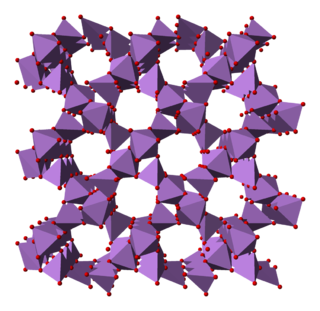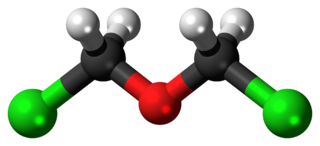
VG is a "V-series" nerve agent chemically similar to the better-known VX nerve agent. Tetram is the common Russian name for the substance. Amiton was the trade name for the substance when it was marketed as an insecticide by ICI in the mid-1950s.
Benzyl chloride, or α-chlorotoluene, is an organic compound with the formula C6H5CH2Cl. This colorless liquid is a reactive organochlorine compound that is a widely used chemical building block.

Arsenic pentoxide is the inorganic compound with the formula As2O5. This glassy, white, deliquescent solid is relatively unstable, consistent with the rarity of the As(V) oxidation state. More common, and far more important commercially, is arsenic(III) oxide (As2O3). All inorganic arsenic compounds are highly toxic and thus find only limited commercial applications.

Chloromethyl methyl ether (CMME) is a compound with formula CH3OCH2Cl. A colorless liquid, it is a chloroalkyl ether. It is used as an alkylating agent. In organic synthesis, it is used for introducing the methoxymethyl (MOM) protecting group, and is thus often called MOM-Cl or MOM chloride. It also finds application as a chloromethylating agent in some variants of the Blanc chloromethylation.

Bis(chloromethyl) ether is an organic compound with the chemical formula (CH2Cl)2O. It is a colourless liquid with an unpleasant suffocating odour and it is one of the chloroalkyl ethers. Bis(chloromethyl) ether was once produced on a large scale, but was found to be highly carcinogenic and thus such production has ceased.

Bromadiolone is a potent anticoagulant rodenticide. It is a second-generation 4-hydroxycoumarin derivative and vitamin K antagonist, often called a "super-warfarin" for its added potency and tendency to accumulate in the liver of the poisoned organism. When first introduced to the UK market in 1980, it was effective against rodent populations that had become resistant to first generation anticoagulants.

Chlorophacinone is an anticoagulant used as a rodenticide. It is classified as an extremely hazardous substance in the United States as defined in Section 302 of the U.S. Emergency Planning and Community Right-to-Know Act and is subject to strict reporting requirements by facilities which produce, store, or use it in significant quantities.

Chloroxuron is an organic compound with the chemical formula C15H15ClN2O2 used as an herbicide. It is classified as an extremely hazardous substance in the United States as defined in Section 302 of the U.S. Emergency Planning and Community Right-to-Know Act (42 U.S.C. 11002), and is subject to strict reporting requirements by facilities which produce, store, or use it in significant quantities.

Isobenzan (telodrin) is a highly toxic organochloride insecticide. It was produced only in the period from 1958 to 1965 and its use has been since discontinued. It is a persistent organic pollutant that can remain in soil for 2 to 7 years, and the biological half-life of isobenzan in human blood is estimated to be about 2.8 years.

Acetone thiosemicarbazone is a chemical compound with the molecular formula C4H9N3S. It is used in the plastics industry in the manufacture of polyvinyl chloride (PVC) to terminate the polymerization process.

Azinphos-ethyl was a broad-spectrum organophosphate insecticide.

Cyanophos is a cholinesterase inhibitor used as an insecticide and avicide; for example, against rice stem borers and house flies. It is part of the chemical class of organophosphorus compounds, and is a yellow to reddish-yellow transparent liquid.

Oxamyl is a chemical used as a pesticide that comes in two forms: granulated and liquid. The granulated form has been banned in the United States. It is commonly sold under the trade name Vydate.

Bitoscanate is an organic chemical compound used in the treatment of hookworms. It is classified as an extremely hazardous substance in the United States as defined in Section 302 of the U.S. Emergency Planning and Community Right-to-Know Act, and is subject to strict reporting requirements by facilities which produce, store, or use it in significant quantities.

Bis(chloromethyl) ketone is a chemical substance with formula C
3H
4Cl
2O. It is a solid, and is used in the making of citric acid. Exposures such as contact or inhalation of bis(chloromethyl) ketone can result in irritation or damage to skin, eyes, throat, lungs, liver and kidneys, as well as headaches and fainting.

Tirpate is a pesticide and nematocide. As of 1998, the United States Environmental Protection Agency listed the substance as discontinued in manufacturing. It is classified as an extremely hazardous substance in the United States as defined in Section 302 of the U.S. Emergency Planning and Community Right-to-Know Act, and is subject to strict reporting requirements by facilities which produce, store, or use it in significant quantities.

Isopropylmethylpyrazolyl dimethylcarbamate is a chemical compound used in Europe in aphicides and insecticides. As of 1998, the United States Environmental Protection Agency listed it as an unregistered pesticide in the United States. In China, it is used under the name isolan.
Lactonitrile is the organic compound with the formula CH3CH(OH)CN. It is an intermediate in the industrial production of ethyl lactate and lactic acid. It is the cyanohydrin of acetaldehyde. It is a colorless liquid, although degraded samples can appear yellow.

Oxydisulfoton is a chemical compound used as an acaricide and insecticide. It is classified as an extremely hazardous substance in the United States as defined in Section 302 of the U.S. Emergency Planning and Community Right-to-Know Act, and is subject to strict reporting requirements by facilities which produce, store, or use it in significant quantities.

Fluomine is a chemical compound containing a cobalt chelate. It has the ability to form a complex with molecular oxygen (O2) and then release it upon heating. Because of this ability to reversibly sorb and desorb oxygen, it has been used in high-altitude aircraft oxygen-generating systems.



















